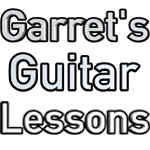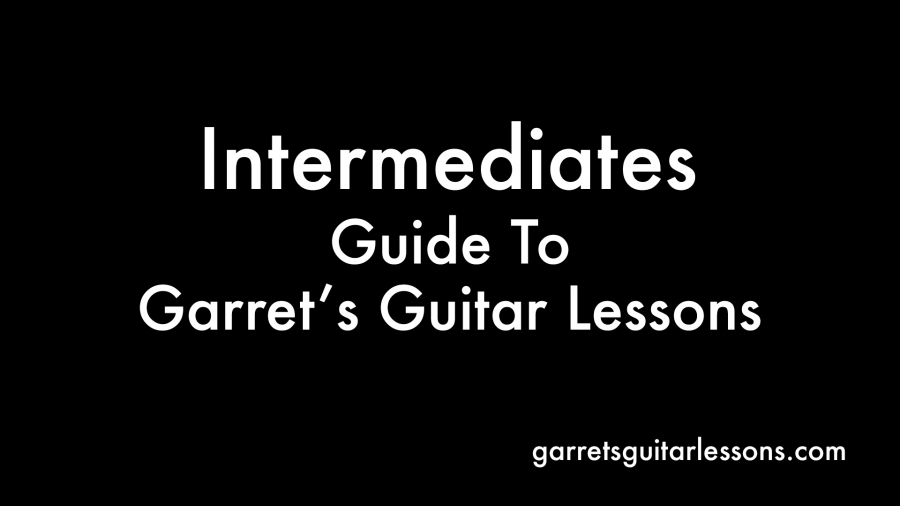So you’ve been playing guitar for a little while but not sure where to go next? Here are some starting points to get you rolling and get you over the next hump. It’s nearly impossible to accurately assess where you’re at without hearing you, so these are general guidelines.
What is intermediate? How do I know if I’m a beginner or advanced?
I think everyone has a different definition of what Beginner, Intermediate and Advanced is. I think having a solid foundation of open chords (including sus chords, and 7th chords), barre chords (6th string, 5th string and 7th chords), strumming (rhythms) and transitioning between chords completes your tenure as a beginner. I think “intermediate” guitar playing, the next step, is the most broad. This step involves visualizing chords, arpeggios and scales in different “shapes” all over the neck, utilizing and internalizing these all over the neck in songs, solos and what not, focusing on different genres, understanding basic theory, knowing some more complex chord shapes and focusing on different techniques.
Wow… quite a lot, eh?
I think what you focus on largely depends on what you’re influenced by and what your goals are. Here are some free lesson videos to help you get there, organized the best way I can without hearing you personally. In each lesson are links to PDF’s that aid the lesson, links to my Play Alongs of chords, arpeggios, scales and Backing Tracks to jam along to!
CAGED Shapes
CAGED Shapes will be the topic of a blog all on it’s own. The big thing with these is it’s a way to use our open chord “shapes” (C, A, G, E, D) into movable chord “shapes” to visualize different sections of the fretboard. We use the chord shapes as a template that we plug our arpeggios/scales into. This isn’t the only way to organize and visualize the fretboard, but this is the one I’ve chosen to keep consistent throughout my site and PDF’s. I tag these videos as “CAGED Overview” (or CO) and there are 10 in the series.
*Not sure if you’re ready for the CAGED shapes? Grab your capo and check this video out which goes through the visualization aspect of the CAGED shapes but without the stretches in actually playing them:
*Capo Thinkage
1) Major CAGED Chord Shapes | CO 1/10
2) Minor CAGED Chord Shapes | CO 2/10
3) Major CAGED Arpeggio Shapes | CO 3/10
4) Minor CAGED Arpeggio Shapes | CO 4/10
5) Major CAGED Pentatonic Shapes | CO 5/10
6) Minor CAGED Pentatonic Shapes | CO 6/10
7) Major CAGED Scale Shapes | CO 7/10
8) Minor CAGED Scale Shapes | CO 8/10
9) Practice and Apply CAGED Shapes | CO 9/10
10) Relative Minor | CO 10/10
Don’t skip this part – Intermediate Rhythm Guitar
Most hear AC/DC and think the way guitar-ing works is you have a “rhythm” player and a “lead” player so pick one and focus on it. In reality, rhythm guitar and lead guitar work in conjunction with each other. One of the best pieces of advice I have if you want to get better at soloing/lead guitar, work on your rhythm playing. Not just playing your ‘go-to’ chord shapes, but work on different chord shapes, triads, key changes and you’ll notice your soloing getting better. How?! The more you use different chord shapes and tethering arpeggios/scales to them… you’ll find the whole neck starting to open up. I have some Premium Lessons that thoroughly covers some of the ideas, but here are some good starting places.
1) Triads
2) Slash Chords | Inversions
3) Add9 Chords
4) Extended Chord Shapes
5) Looping/Playing With Others
6) Using Extended Chords
7) Adding Cool Chords to Your Songs | Borrowed Chords
8) Hendrix Style of Rhythm Playing | Major Chords
9) Hendrix Style of Rhythm Playing | Minor Chords
10) Using Diminished Chords
Lead Guitar Walk Through
As I mentioned above, the line between “Rhythm Guitar” and “Lead Guitar” can be pretty blurry. Here are some things that should help push your lead guitar playing to the next step.
Lead Guitar Tools
1) Triads
2) Wide Interval Triads
3) How To Use and Apply Wide Interval Triads
4) Horizontal Scales | Single String Scales
5) Octave Patterns
6) Harmonizing Your Solos
7) Acoustic Guitar Soloing
8) Tapping Guitar Intro
9) Solo Better Over Tons of Songs | 1 5 6 4
10) Blending Major & Minor Pentatonic Scales
11) Usable Blues Shapes
12) Blues Triads
13) Country Guitar Techniques
14) Using Your Whammy Bar
15) 3 Note Blues Soloing
Lead Guitar Techniques
1) Finger Exercises & Warm Ups
2) Finger Exercises & Warm Ups | 2
3) Slides, Hammer-Ons, Pull-Offs & Rakes
4) Bending & Vibrato
5) Scale Exercise | 3 Note Pattern
6) Major Scale Intervals | 3rds
7) Major Scale Intervals | 4ths
8) Major Scale Intervals | 5ths
9) Major Scale Intervals | 6ths
10) Major Scale Intervals | 7ths
Lead Guitar Licks
1) Blues Licks
2) Blues Licks | 2 | Major
3) Rock Licks
4) Rock Licks | 2
5) Country Licks
6) Country Licks | 2
7) 9th Licks
8) Major Arpeggio Inspired Licks
Theory
Either at the beginning of your intermediate journey or at the end, starting to understand where music comes from and why they’re there will really fill in a lot of the gaps. Here are some videos to help clear the chaos. I label the theory videos as “Usable Guitar Theory” (or UGT for short). They’re meant to give you a clear, step-by-step walk through of theory from knowing nothing, to feeling comfortable with it.
1) What’s a Scale?! | UGT 1/8
2) Building Chords?! | UGT 2/8
3) Building Extended Chords?! | UGT 3/8
4) Naming a Chord?! | UGT 4/8
5) Chords as Number (Transposing)?! | UGT 5/8
6) Chords Don’t Fit?! | UGT 6/8
7) Finding the Key?! | UGT 7/8
8) Basic Guitar Theory in Under 7 Minutes | UGT 8/8
Everything covered above can certainly help push you above and beyond. Depending on where you’re personally at in your guitar playing and where you want to go these can help get you over the hump your on now or the one you’ll be at soon enough (unfortunately… it is inevitable). Since I’m constantly uploading new free lesson videos, there may be some I upload in the future that will continue to help. I also have Premium Lessons going into detail on using CAGED shapes and Triads (both for rhythm and lead playing).
If you have any questions, send me a message through my “Contact” page or visit my “Live Lessons” for more a more personalized approach.

